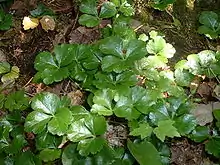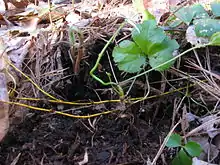| Threeleaf goldthread | |
|---|---|
 | |
| Coptis trifolia, Pancake Bay, Ontario | |
| Scientific classification | |
| Kingdom: | Plantae |
| Clade: | Tracheophytes |
| Clade: | Angiosperms |
| Clade: | Eudicots |
| Order: | Ranunculales |
| Family: | Ranunculaceae |
| Genus: | Coptis |
| Species: | C. trifolia |
| Binomial name | |
| Coptis trifolia | |
| Synonyms | |
|
Coptis groenlandica | |

Coptis trifolia, commonly known as the threeleaf goldthread or savoyane, is a perennial plant in the genus Coptis, a member of the family Ranunculaceae.
Distribution
It is native to North America and Asia across the subarctic region.[1][2] Its range is divided into three broad groups. The first is from southern Greenland and Labrador that extends to Manitoba to the west and to the mountains of North Carolina to the south. The second is in Alaska and adjacent areas of British Columbia, extending towards eastern Siberia and into Japan and Manchuria. Records from Norway and central Russia are most likely based on confusion.[3] The disrupted and wide range of the species suggests that the three populations have been isolated from each other for significant periods of time.[3]
Goldthread seems to prefer coniferous or mixed canopies dominated by Eastern hemlock, but it has also been found in deciduous canopies in moist, acidic soils.[4]
Description
Goldthread has at least one small, deeply three-lobed, evergreen leaf rising from the ground. It has between four and seven white, petaloid sepals, though no true petals. It has between four and seven clavate and numerous stamen. It is usually between five and fifteen centimeters tall, with each stalk having a single flower or three leaflets. Its fruits contain a number of small seeds. The name goldthread is derived from the plant's bright yellow rhizome.[4]
Medicinal uses
The rhizome of the plant was chewed by Native Americans, including Algonquian-speaking peoples and the Iroquois, to relieve canker sores, and is the source of another common name, canker-root.[5][6] It has also been used to make a tea that is used as an eyewash.[7] Like the medicinal plant goldenseal, goldthread is used to treat symptoms of influenza and the common cold. Coptis trifolia has been shown to be biologically active against E.coli and Bacillus subtilis. The active compounds of Coptis trifolia are the alkaloids berberine and coptine.[4]
Ecology
In 1963, a species of fungus in the genus Lambertella, Lambertella copticola, was discovered growing on the dead leaves of a Coptis trifolia.[8]
Species of the fungal genus Gloeosporium can infect Coptis trifolia, as well as other species of Coptis, and reduce normal plant function. The slug Arion fasciatus also feeds on goldthread. Other external threats to Coptis trifolia include logging, fire, agricultural development, and human recreation.[4]
Gallery


 Blossom
Blossom Foliage and seed pods
Foliage and seed pods
References
- ↑ "Coptis trifolia (L.) Salisb. | Plants of the World Online | Kew Science".
- ↑ "Lady Bird Johnson Wildflower Center - the University of Texas at Austin".
- 1 2 Fernald, M. L. (1929). "Coptis Trifolia and Its Eastern American Representative". Rhodora. 31 (367): 136–142. JSTOR 23300838.
- 1 2 3 4 Balunas, Marcy (2003). Ecological characteristics, harvesting impacts, and restoration potential of goldthread (Coptis trifolia (L.) Salisb.), a medicinal plant (Thesis). OCLC 59283836. ProQuest 250195175.
- ↑ "Lady Bird Johnson Wildflower Center - the University of Texas at Austin".
- ↑ "BRIT - Native American Ethnobotany Database".
- ↑ Niering, William A.; Olmstead, Nancy C. (1985) [1979]. The Audubon Society Field Guide to North American Wildflowers, Eastern Region. Knopf. p. 734. ISBN 0-394-50432-1.
- ↑ Tewari, V. P. (1963). "Morphology and Physiology of a New Species of Lambertella on Coptis trifolia". Mycologia. 55 (5): 595–607. doi:10.2307/3756436. JSTOR 3756436.
External links
- rook.org
- Coptis trifolia Image - Flavon's art gallery
- Lady Bird Johnson Wildflower Center